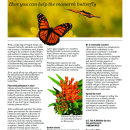Education & science
Learners of any age can make a difference in conserving monarchs. Studying the life cycle and migration of monarchs, as well as learning about their habitat needs, can help support their conservation. The U.S. Fish and Wildlife Service has different kinds of educational resources on monarchs. Read about monarch, participate in lesson plans and watch educational videos. By knowing more about monarchs, you can help protect them and teach others the importance of this incredible species!
Get involved
Every action counts! You can help monarchs and pollinators by planting native milkweed and nectar plants. Every little bit of habitat benefits pollinators. Habitat for pollinators is everyone’s responsibility.
If you want an even more active role in protecting monarchs, consider becoming a citizen scientist. Citizen scientists are volunteers of all ages who help with scientific research. Anyone can participate in data collection and the scientific understanding of monarch butterflies. There are a variety of citizen science projects across the country that contribute important data to our understanding of monarchs and their population number. Check out the Monarch Joint Venture website to find a full list of monarch citizen science projects. Check out this citizen science success story: Citizen science for monarch monitoring in the Saline Valley, California.
What about captive rearing?
We do not recommend captive rearing or interstate movement of monarch butterflies or their larvae (caterpillars) for conservation. Studies indicate that captive-reared monarchs have less migratory ability, and greater probability or genetic complications and disease.
If you want to help monarchs, we recommend planting native nectar plants and milkweeds that are free from pesticides and appropriate for their location, to enhance butterfly habitat.
The U.S. Department of Agriculture's Animal and Plant Health Inspection Service is the authorized agency to regulate the facilitation of safe trade of agricultural products, which includes the monarch butterfly. We recommend contacting them for information on monarch captivity.
Highlighted stories
Education resources
Check out the monarch butterfly conservation webinar series for a unique opportunity to hear from experts across a wide range of interdisciplinary fields related to monarchs, other pollinators, their habitat and the threats and pressures that make conservation urgent.









